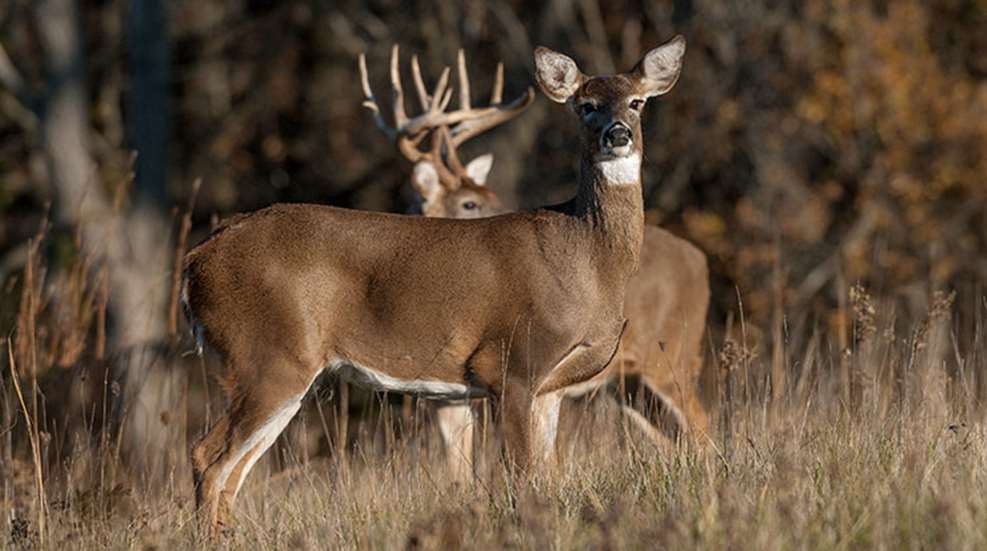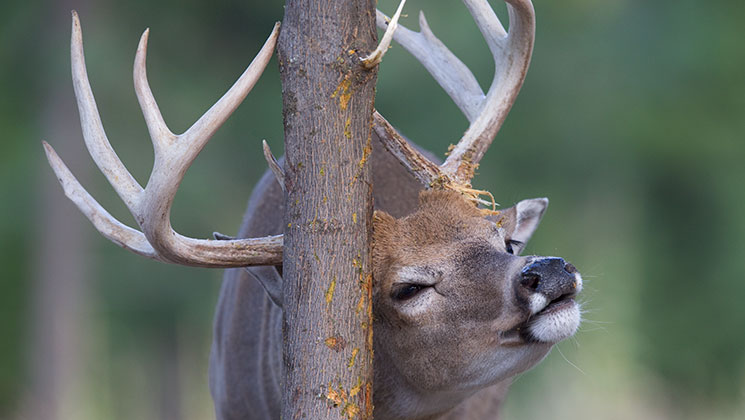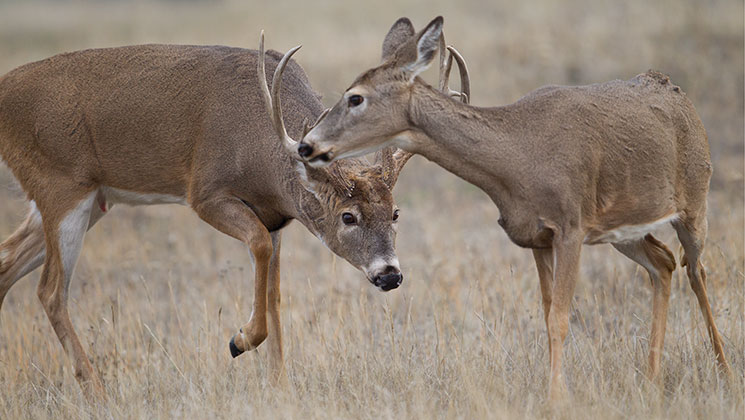
In the northern and central states and Canada, the whitetail rut is about to explode in a frenzy that anyone with their eyes open will notice as bucks heedlessly cross farm fields, suburban yards and roads in their furious search for does in estrus. But the rut isn’t just a time of frenzy. The seeking, chasing and breeding phases of the rut that occur in November across much of the whitetail’s range often require different strategies. Here’s a week-by-week guide to staying in step with the rut this month to up your odds of tagging the buck you want.
November 1-7
Halloween is just gone but some of the trees are still pumpkin orange. The fallen leaves have a fresh, damp, musky smell in the early morning. Saplings have been rubbed raw along field edges and all over the woods, and scrapes seem to be everywhere. The young bucks are harassing does now like exuberant teenagers, but the older bucks, though they are scraping and rubbing, aren’t yet moving hard in search of does.
Bucks are feeling the testosterone, sure, but the older ones are mostly moving on a pattern. Ignore the scrapes along field edges and other open places. Follow a rub line back from a feeding area into the woods and set up where you find a cluster of rubs, a place a buck is staging before heading out to feed. These will often be on finger ridges that come off larger ridges or on points between bottoms. The best time to hunt is still in the evening, but that is about to change and is not the hard rule it was in early to mid-October.
This week you want to be in travel corridors between a buck’s bed and food, especially when cold fronts pass through and immediately after. You want to carefully—with good entry and exit strategies—hunt these transition places where bucks move between feeding and bedding while scent-checking does. Evening sits should put you just downwind of well-worked scrapes located back in the forest and as close to bedding cover as you can safely get. Bucks are checking on does, but almost none have come into estrus yet. Mature bucks will be the last to move now.

November 8-14
One day, maybe Wednesday, Nov. 8, the rut will seem to simply explode like a Spanish fiesta. This is a wonderful but brief window when a few does are in estrus and all the bucks, including the biggest in your woods, are on their feet around the clock looking to breed. Soon the dominant bucks will seem to disappear as they find secluded places to hang out with and breed does. But now, with bucks searching hard for the limited does that have just come into estrus, is an opportunity you won’t see again until the rut begins to wane.
If the wind is right, this is the time to spend all day in those stands hung in bottlenecks where deer trails come together between doe bedding areas. You want to be back in the thickets at trail intersections where there are scrapes and rubs.
Cold, quiet mornings this week can be the best times of all season to rattle. Crash the antlers together for 30 seconds, and then wait five to 10 minutes before rattling again. Whether you rattle or not, use a grunt call to make deep, guttural grunts every so often. You never know if a buck is cruising just out of sight but not out of earshot. This is the time of year when one is most likely to turn and come in; be ready for it to circle downwind.
November 15-21
Some hunters think of this week as the lull in the November rut. If you hunt a place where does far outnumber bucks—let’s face it, most of us do—then a mature buck only has to leave one doe and walk around a little before it finds another to breed. A buck will hole up with a hot doe for 24-36 hours, and the pair will typically remain in a small area. That doesn’t give us much of a chance to catch a dominant buck in daylight this week.
So even though you know the rut is on, now you aren’t seeing much. Then, all of a sudden, you might spot a chase in the next woodlot. There could be a dozen does and other bucks tagging along watching the excitement, but then it ends and you go back to not seeing much at all.
Meanwhile the bow season might be over or closing soon in your area, and the gun season means more pressure. The best strategy this week is to sit in a funnel that connects larger areas where deer bed. Study your maps and find hidden spots where different terrain features come together. The thicker and rougher the place, the better. Look for places within the cover where terrain features bring trails together. Beware of bottoms, as winds swirl in them, and look for higher places where you can watch with bow or gun for bucks slipping around in daylight during what might be their short hunts for does.
Be patient. GPS-collar studies on rutting bucks have shown they’ll often switch from one side of their range to another during the rut. If you’re seeing does, sooner or later a buck is going to show up.

November 22-30
When bucks start chasing and breeding does in mid-November they typically stop checking and working scrapes. But as the main part of the rut winds down and fewer and fewer does are in estrus, bucks begin checking and working scrapes again. Maybe the more mature bucks know they’ll get another chance to breed; the few does that weren’t bred during the first peak of the rut, and the fawns that simply weren’t ready to breed in November, will come into heat in December. For this reason older bucks keep checking scrapes. Look to see if any have been worked near your stands.
Older bucks will even get up from their beds around midday in the late rut. They slowly walk through thickets and other bedding areas as they search for does. Hunting pressure has by now taught them to stay out of the fields and open woods, but they will often stealthily cruise areas where they feel safe in daylight even during the gun season. The trick is finding a stand you can hunt low-impact (meaning you can sneak in and out of it without spooking deer) that gets you back into those thick buck-safety zones where most hunters don’t go.
Quick Tips
- Don't be afraid to move if you hunt a spot for two days without seeing deer. Hunting pressure might have shut down the spot, or a new food source might have moved the deer.
- Always carry a grunt call during the rut. If a buck cruises by out of range, then get on your grunt tube to call the buck closer.
- Hunt all day from stands in heavy cover and in funnels between bedding areas, starting the second week of November. Many find it surprising just how many big bucks are killed at noon. Part of the reason is other hunters bump deer when they leave the woods at 10 a.m. But mostly it’s because deer learn our behavior, too.
- Pull a rag dipped in doe-in-heat scent along the edge of cover during the last weeks of the month. Even though you can’t cover all the entry and exit routes, at least a cruising buck might pick up the trail and come to you.
- Ignore the moon. Wildlife biologists haven’t been able to find a reliable link between moon phase and rut activity. Instead, pay attention to temperature, the barometer and other weather factors, as an incoming front increases deer movement.



































